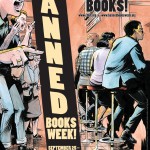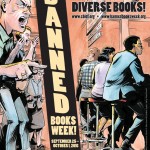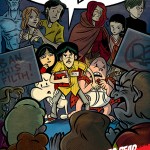The Comic Book Legal Defense Fund is a proud sponsor of Banned Books Week, the annual celebration of the freedom to read! The celebration of Banned Books Week is always held the last week of September and features a different theme every year.
THE PROBLEM
Every year people try to take away readers’ power to decide what books are right for themselves or their children to read by bringing challenges to remove books from libraries. Comic books, graphic novels, and manga are frequently challenged and even banned.
WHY COMICS ARE BANNED
Book banning is nothing new. Books are frequently banned for containing “adult content,” “language,” “sex/nudity,” or not being “age appropriate.” Comics are uniquely vulnerable to challenges because the medium thrives on the power of static images, and because there is a lingering stigma that comics are low-value speech. Some challenges are brought against comics because a single page or panel can be taken out of context, while others come under attack because of the mistaken notion that all comics are for children. Learn more about why comics are banned here.
WHAT COMICS ARE BANNED
Comics are one of the most commonly attacked types of books, with challenges and bans happening every year. A few years ago, attempts to ban critically acclaimed graphic novels Persepolis and Barefoot Gen made international headlines. In recent years, Raina Telgemeier’s hit graphic novel set in middle school, Drama, has become one of the most frequently challenged books around the country year after year, and despite the mainstream success of the popular Broadway show, Alison Bechdel’s acclaimed memoir Fun Home still faces challenges in schools. Learn more about what comics have been banned or challenged here.
WHAT CBLDF DOES TO HELP
CBLDF assists librarians by providing access to resources and writing letters of support in cases where comics are challenged. In the past year the CBLDF has participated in helping several challenges and stands ready to address new ones when they occur. CBLDF is also an active sponsor of Banned Books Week and the Kids Right To Read Project, initiatives that create tools and perform activities that advance the freedom to read.
Every year the focus changes, past themes have included; Celebrating Diversity, Our Right to Read, and Banning Books Silences Stories. The week is a reminder that everyone must stand up to censorship. CBLDF Executive Director Charles Brownstein said, “Banned Books Week gives everyone a chance to celebrate their story. The courageous students, teachers, librarians, and authors who stand up for challenged ideas remind us that intellectual freedom is our birthright. By creating an event for your community, posting online about the freedom to read, or even just reading a banned book, each person has an opportunity to further that right.”
If you are hosting an event or Banned Books Week display, let us know about it! Register your event with Banned Books Week at http://www.bannedbooksweek.org/events
RESOURCES
Below are some of CBLDF’s resources for Banned Books Week. Below are the handbook, posters, and more to help you make a celebration of diverse banned books! We’re adding resources every year, so be sure to check back.
Banned Books Week 101
For an introduction to banned books and Banned Books Week, visit CBLDF’s FAQ: Banned Books Week 101.
CBLDF Banned Books Week Handbook
The CBLDF Banned Books Week Handbook is a free resource that gives you the scoop about what comics are banned, how to report and fight censorship, and how to make a celebration of Banned Books Week in your community! CBLDF’s Banned Books Week Handbook is an essential tool to assist librarians, educators, and retailers in planning their Banned Books Week celebrations, while also being a vital reference to help readers everywhere fight censorship.
View or download the CBLDF Banned Books Week Handbooks both past and present here.
CBLDF Comics Connector
The CBLDF Comics Connector is a free a resource that lists comics creators and industry professionals who are able to provide lectures and workshops for schools and libraries. The CBLDF Comics Connector is organized by country, followed by state or province, and entries in each state are alphabetical by creator’s last name. Currently, the CBLDF Comics Connector includes dozens of creators from 22 US states and three Canadian provinces. Odds are good you’ll be able to find someone who will participate in your Banned Books Week events!
Check out the CBLDF Comics Connector here. If you are a creator or industry professional who would like to be listed in the CBLDF Comics Connector, please fill out this Google Form, and we’ll add you to the list! Educators and librarians, if you have suggestions to improve this resource, please contact us at info@cbldf.org.
CBLDF Posters and Shelf Talkers
First up, we have a poster adapting Raina Telgemeier’s amazing cover for the 2015 edition of the CBLDF Banned Books Week Handbook! We’re also delighted to offer a poster featuring characters from banned and challenged comics courtesy of Jonathan Hill and First Second Books. Finally, we have Jeff Smith’s Bone, waving a flag for the freedom to read!
Feel free to use these great posters in your Banned Books Week displays and to advertise your events celebrating the freedom to read! Click on the links below to download high-res versions of each:
- Nate Powell CBLDF Banned Books Week Handbook 2016 poster, featuring artwork from John Lewis and Andrew Aydin’s March (11″ x 17″)
- Nate Powell CBLDF Banned Books Week Handbook 2016 poster, featuring artwork from John Lewis and Andrew Aydin’s March (8.5″ x 11″)
- 11″ x 17″
- 8.5″ x 11″
- Raina Telgemeier CBLDF Banned Books Week Handbook poster, featuring Callie from Drama (8.5″ by 11″)
- Jonathan Hill multi-character poster, featuring banned and challenged comic book characters (11″ by 17″)
- Jeff Smith CBLDF Banned Books Week Handbook poster, featuring Bone (11″ by 17″)
We’re also delighted to offer shelf talkers for stores, libraries, and classrooms! Featuring “Fighting Words” about censorship from some of the biggest names in comics, you can use these shelf talkers to call attention to banned books, as part of your Banned Books Week displays, on bulletin boards, and more! Featuring quotes from Neil Gaiman, Jeff Smith, Marjane Satrapi, Alan Moore, Frank Miller, Alison Bechdel, and Ariel Schrag, this who’s who of challenged creators will inspire your Banned Books Week celebration!
We have two formats: An 11″ by 17″ spread that features all of the quotes or a version that you can cut apart into individual blurbs to customize your shelves and displays. Click on the links below to dowload high-res versions of each:
- CBLDF Banned Books Week A Shelftalker Spread (11″ by 17″)
- CBLDF Banned Books Week A Shelftalker Spread (11″ by 17″ with bleed)
- CBLDF Banned Books Week B Shelftalker Spread (11″ by 17″)
- CBLDF Banned Books Week B Shelftalker Blurbs
Raising A Reader: How Comics & Graphic Novels Can Help Your Kids Love to Read!
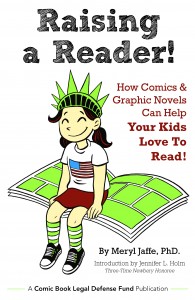 With more than 80,000 copies in print, Raising a Reader! How Comics & Graphic Novels Can Help Your Kids Love To Read! answers the questions parents and educators bring to using comics: What skills do graphic novels offer kids? How do you teach reading with a comics page? How do comics promote a love of reading? It’s an indispensable tool for showcasing the value of graphic novels, and chock full of reading suggestions and title recommendations to get kids engaged with this exciting medium! Check it out here.
With more than 80,000 copies in print, Raising a Reader! How Comics & Graphic Novels Can Help Your Kids Love To Read! answers the questions parents and educators bring to using comics: What skills do graphic novels offer kids? How do you teach reading with a comics page? How do comics promote a love of reading? It’s an indispensable tool for showcasing the value of graphic novels, and chock full of reading suggestions and title recommendations to get kids engaged with this exciting medium! Check it out here.
Using Graphic Novels in Education
Using Graphic Novels in Education is an ongoing feature from CBLDF that is designed to allay confusion around the content of graphic novels and to help parents and teachers raise readers. In this column, we examine graphic novels, including those that have been targeted by censors, and provide teaching and discussion suggestions for the use of such books in classrooms. Check out the columns here.
Adding Graphic Novels to Your Library or Classroom Collection
This ongoing feature from CBLDF provides specific resources for librarians and educators who may need to justify and defend the inclusion of the book in library and classroom collections. Each column provides specific information about a book, including a summary of challenges it has faced, reviews, praise, awards and other recognitions, and additional CBLDF resources that educators and librarians can provide to their administrators when they want to add the book to their collections. Check out the series here.
CBLDF Discussion Guides
Given their visual nature, comics are easy targets for would-be censors. CBLDF’s Discussion Guides are tools that can be used to lead conversations about challenged graphic novels and to help allay misconceptions about comics. Click through to download the guides.
CBLDF Banned Comics Case Studies
Collecting case studies about specific comics that have been challenged or banned, this series has details on which comics were attacked, why, and what CBLDF did to help defend them. Read all about it here.
CBLDF Defender
CBLDF Defender is our free quarterly news magazine coming to you from the front lines of the fight for free speech! Each issue of CBLDF Defender brought engaging creator interviews, detailed analysis of current censorship news, and in-depth features that tell the story of the people fighting for the freedom to read! Click through to read our past issues of CBLDF Defender!
Comic Book Club Handbook
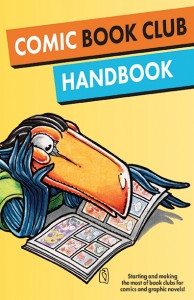 Learn how to start and make the most of book clubs for comics and graphic novels with the Comic Book Club Handbook, a resource produced by Comic Book Legal Defense Fund in collaboration with Comic-Con International! Designed for librarians, retailers, and individuals alike, the Comic Book Club Handbook goes inside the how’s and why’s of creating a graphic novel book club. The handbook provides proven strategies for getting started, selecting books, engaging your community, managing discussions, and much more, including a helpful table of books to get you started!
Learn how to start and make the most of book clubs for comics and graphic novels with the Comic Book Club Handbook, a resource produced by Comic Book Legal Defense Fund in collaboration with Comic-Con International! Designed for librarians, retailers, and individuals alike, the Comic Book Club Handbook goes inside the how’s and why’s of creating a graphic novel book club. The handbook provides proven strategies for getting started, selecting books, engaging your community, managing discussions, and much more, including a helpful table of books to get you started!
This publication is the latest in the ongoing education collaboration between Comic Book Legal Defense Fund and Comic-Con International, who co-produced the handbook with the assistance of Erwin Magbanua of the San Diego Public Library. The Comic Book Club Handbook is illustrated throughout by legendary cartoonist Rick Geary! Read it here.
Manga Book Club Handbook
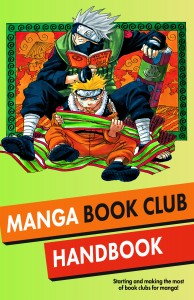 The Manga Book Club Handbook is invaluable resource, created in partnership with VIZ Media, that will help you start and make the most of book clubs for manga! The Manga Book Club Handbook lays out the basics of manga and provides the tools you need to start a book club for manga, including suggested readings to get you started! Read it here.
The Manga Book Club Handbook is invaluable resource, created in partnership with VIZ Media, that will help you start and make the most of book clubs for manga! The Manga Book Club Handbook lays out the basics of manga and provides the tools you need to start a book club for manga, including suggested readings to get you started! Read it here.
Working With Libraries! A Handbook For Comics Creators
Working With Libraries! provides comics creators with a valuable insider’s perspective on the library world and the systems librarians have to navigate to bring comics to their patrons. The handbook details the basics of public, school, and academic libraries, explains the collection development process, and offers suggestions for ways creators can collaborate with libraries in developing events and programs. View it here
